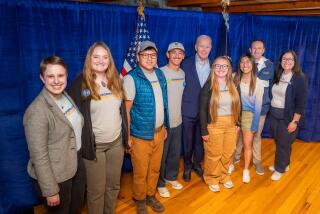Wyoming Is Wanting a Conservation Program
- Share via
CHEYENNE, Wyo. — Open spaces. Snowcapped mountains. Beautiful scenery.
Wyoming’s attractions draw plenty of young people who want to work outdoors during the summer, especially those who participate in conservation corps programs -- service groups hired to work on community and public-land improvement projects.
But most of those young people aren’t coming from Wyoming. Conservation corps from Utah, Montana and Colorado have all done projects in Wyoming because Wyoming has no corps of its own.
Students at the University of Wyoming and a state lawmaker want to change that, but their approach has generated some controversy.
Wyoming law student Nicholas Agopian and state Sen. Kit Jennings (R-Casper) want to see a tie between the corps and the energy industry, saying the recent boom provides ample opportunity for reclamation projects the corps could work on. Both say the program could influence the next generation of miners and petroleum engineers on environmental concerns.
But people involved with conservation corps elsewhere have warned against that tie.
Jono McKinney, executive director of the Montana Conservation Corps, said it was important to think of conservation corps as youth development programs, not cheap labor.
“If the energy sector that is supporting this sees it as workforce and youth development, that is good,” McKinney said. “But if they see it as a cheap way to fix some of their messes, I think it will backfire.”
Matt Ferris, special projects coordinator for the National Assn. of Service and Conservation Corps, echoed McKinney’s concerns.
“If it’s something the corporation is trying to do to escape its responsibility, that’s not a good thing,” Ferris said. “But if it’s something the corporation is trying to do to be responsible and to involve youth by giving them work skills and a sense of accomplishment, then that’s a good thing.”
That’s exactly what Agopian, who worked for the Montana Conservation Corps in 2001 after graduating from the University of Montana, wants to achieve. He said the corps was an excellent tool for instilling a community service ethic in young people.
“I’m a great example of this,” Agopian said. “I didn’t have much experience doing community service work before doing the program. Since then, I’ve been involved with several other nonprofit organizations, and I’m back wanting to create this program for the state because I think it’s such a great program.”
Jennings said such a program would put “a streak of green” into future energy industry professionals. He wants to get them thinking about the effect drilling has on the surface of the land.
“Sometimes we get tunnel vision on what our job is, and if your job is to go get that energy out of the ground and make money, sometimes you forget about the guy that lives on the surface,” Jennings said.
Agopian, fellow law student Matt Kelly and Robyn Paulekas, program advisor at the University of Wyoming’s Center for Volunteer Service, wrote the proposal to create the corps, which received backing from the student government.
It would be different from other volunteer opportunities the university offers because it’s focused primarily on the environment, Paulekas said.
“One of the goals for this is for people to come away with a bigger connection to Wyoming and know what it’s about to be from Wyoming,” Paulekas said. “When you’re working hard all day to improve a place, you kind of love it a little more.”
Whether it’s in the oil and gas fields or elsewhere, there is a need.
Bill Oliver, trail and wilderness backcountry manager at the Shoshone National Forest, said corps volunteers had been helpful on projects that didn’t require a lot of movement throughout the forest. He worked with the Montana corps last year and said he thought there would be enough work statewide to support a new Wyoming corps.
“Our conditions are pretty extreme up here, but I think they’re good programs,” Oliver said.
McKinney said the Montana corps had completed several projects in Wyoming, including work in the Shoshone, at Devil’s Tower and in Grand Teton National Park. The group has also worked extensively throughout Yellowstone National Park, which is partially in Montana.
After completing the program, Paulekas and Agopian said, students would receive money from the federal government that would help pay for their education.
And even McKinney said the Wyoming approach of involving energy companies could be an innovative way to keep the corps going. “Corps are not cheap programs,” McKinney said. “If you get energy industry behind it for the right reasons, I think it could be a sustainable model to keep a corps going.”
Ferris said there was a short track record of conservation corps working with corporations nationwide, but he would like to see an increase in this trend.
For now, the program will have to wait. The Legislature rejected Jennings’ attempt to provide about $330,000 in start-up funding. Agopian is looking at other sources of funding and still hopes to have crews out working by the summer of 2007.
“Our legislation failed, and that’s how it works sometimes,” Agopian said. “We’re just going to try to keep to our timeline as it stands.”
More to Read
Sign up for Essential California
The most important California stories and recommendations in your inbox every morning.
You may occasionally receive promotional content from the Los Angeles Times.













